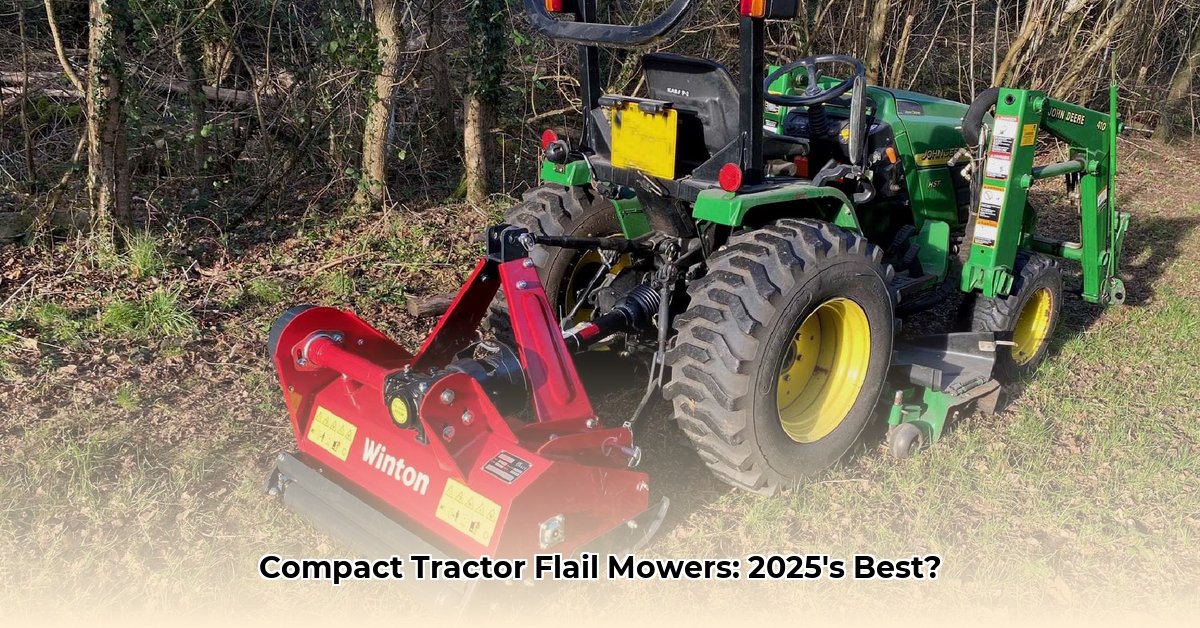
Choosing the right flail mower for your compact tractor can seem daunting. This guide simplifies the process, helping you select the ideal mower for your needs and budget. We'll compare leading brands, explore key features, and provide a step-by-step decision-making process. Whether you're a seasoned farmer or a homeowner tackling a large yard, this guide empowers informed purchasing. For more information on compact tractor implements, see this helpful resource: Compact Tractor Info.
Understanding Your Needs: Before You Begin
Before browsing models, assess your specific requirements. This crucial step will significantly streamline your search and ensure a suitable purchase.
Acreage and Property Shape: How much land needs mowing? A large, flat field allows for a wider mower; a smaller, complex property benefits from maneuverability. Consider the overall shape and size of your property.
Terrain Analysis: Is your land flat, hilly, or rocky? Steep slopes necessitate a mower designed for stability, while rocky areas require extra caution and may benefit from reinforced construction.
Tractor Compatibility: Check your tractor's owner's manual for its Power Take-Off (PTO) horsepower. This determines the maximum power available for driving the mower. Selecting an appropriately sized mower prevents damage and ensures efficient operation.
Budget Allocation: Establish a realistic budget encompassing the initial purchase price, maintenance costs, and potential repairs. A higher initial investment in a durable mower might prove more cost-effective in the long run.
Essential Features: Prioritize critical features like cutting width, flail type (hammer or Y-blades, affecting cutting style and aggressiveness—hammer blades are ideal for thick brush and grass; Y-blades for lighter vegetation), and side-shift functionality (allowing precise cutting near obstacles).
Key Features: A Comparative Analysis
We'll compare popular brands, focusing on Titan Attachments and Baumalight. Note that model-specific variations exist, so always consult the manufacturer's specifications.
| Feature | Titan Attachments (Example Model) | Baumalight (Example Model) | Considerations |
|---|---|---|---|
| Cutting Width | 72 inches | 48 inches | Wider cuts require fewer passes but may compromise maneuverability in tight spaces. |
| Horsepower Needs | 50-60 HP | 30-40 HP | Match your tractor's PTO horsepower. Underpowering can damage the mower; overpowering is wasteful. |
| Side Shift | Often included | May be optional | Essential for precise cutting near fences, trees, or other obstacles. |
| Flail Teeth Type | Hammer blades (typically) | Y-blades or hammer blades | Hammer blades tackle tougher vegetation; Y-blades are suitable for lighter tasks. |
| Price | Generally higher | Generally lower | Balance cost with longevity and required durability. A higher upfront investment can reduce long-term costs. |
| Warranty | Check manufacturer's specifications | Check manufacturer's specifications | A solid warranty reflects confidence in product quality and offers considerable assurance. |
Choosing the Right Mower: A Step-by-Step Guide
This structured approach simplifies the selection process, ensuring you choose the right flail mower for your specific requirements.
Step 1: Prioritize Needs: Based on your assessment, list your top three most critical features.
Step 2: Research and Compare: Use online resources, reviews, and manufacturer websites to find models meeting your criteria. Pay close attention to detailed specifications.
Step 3: Dealer Consultation: Contact local dealers for expert advice, demonstrations, and answering specific questions.
Step 4: Warranty and Maintenance Analysis: Carefully review the warranty and maintenance schedules. Easy maintenance reduces long-term costs and downtime.
Step 5: Finalize Purchase: Once you've made an informed decision, proceed with the purchase.
Maintenance and Troubleshooting: Ensuring Longevity
Regular maintenance is vital for maximizing your investment and preventing costly repairs.
Routine Maintenance Checklist:
- Lubrication: Regular lubrication prevents premature wear and extends component lifespan.
- Blade Inspection: Inspect blades for damage or dullness. Sharp blades are essential for efficient cutting and prevent undue stress on the mower.
- Visual Inspection: Prior to each use, conduct a thorough visual inspection to identify any potential problems.
- Proper Storage: Store the mower correctly during periods of non-use to protect it from the elements.
Troubleshooting Common Issues:
- PTO Shaft Problems: Check for proper engagement and signs of slippage or damage.
- Blade Damage: Damaged or bent blades necessitate immediate replacement.
- Hydraulic Leaks: Address any hydraulic fluid leaks promptly to prevent further damage.
Safety First: Responsible Operation
Safe operation is paramount. Always adhere to the following safety precautions:
- Personal Protective Equipment (PPE): Always wear safety glasses or a face shield, hearing protection, and sturdy work boots.
- Area Clearance: Remove debris, rocks, and wires before starting. These can become projectiles or damage the mower.
- Bystander Safety: Maintain a safe distance to protect people and pets.
- Terrain Awareness: Exercise extra caution on slopes and uneven terrain.
- Regular Inspections: Perform thorough inspections before, during, and after use.
Conclusion: Your Path to the Ideal Flail Mower
Choosing a flail mower requires careful consideration. By following this guide, you can confidently select a model perfectly suited to your needs, ensuring both efficiency and safety. Remember to consult manufacturer resources for model-specific details and maintenance guidelines. Always prioritize safety and follow recommended operating procedures.